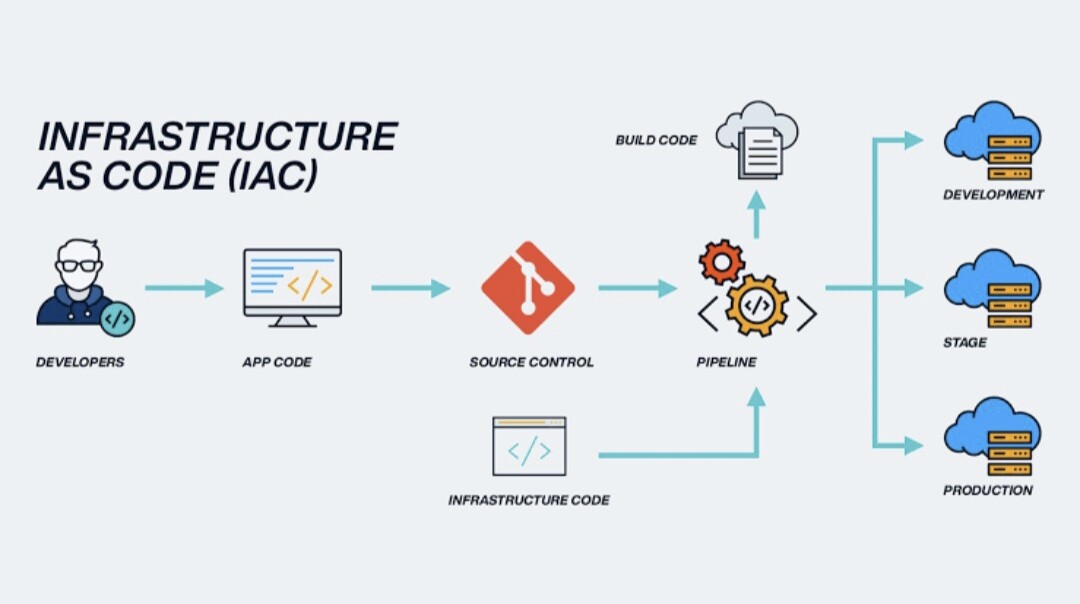What is IAC </>👨🏻💻 !!
 RAKESH DUTTA
RAKESH DUTTA
Usually we write code create infrastructure through IAC. This concept of IAC make CFT as a choice instead of using AWS CLI. There are some principle to IAC, basically it builded on some basic principle. So, according to the principle if we build a IAC tool it will be a medium between users and cloud infrastructure. Infrastructure as Code (IAC) is a method of managing infrastructure through code instead of manual processes.
There are some of the key principles of IaC include :
Idempotence : When we run the same code, it should always give us the same result. This consistency makes it simpler to find and fix problems, test things out, upgrade, and keep equipment stable.
Immutable infrastructure : Creat new infrastructure instead of changing existing resources.
Version control : Store IAC scripts in version control systems to track changes and facilitate collaboration.
Automation : Minimize manual interventions to reduce error rates and increase efficiency.
Repeatable processes : Using IAC for deployments can stop problems during runtime, like missing parts or configuration changes that don't match.
Reproduce systems easily : Our IAC strategies should allow us to build and rebuild any part of our IT setup quickly and easily, without requiring complex decisions or a lot of human effort.
Design is always changing : When designing your infrastructure and software, aim for clarity because it is difficult to predict how system requirements may change in the future.
Testing : Make sure to test our IaC code thoroughly to make sure it works right. Tools like Test Kitchen, Serverspec, and InSpec can help automate testing and find any problems in our infrastructure code.
Benefits of IAC !!
In the past, setting up infrastructure took a lot of time and money because it was done manually. Now, with virtualization, containarization, and cloud computing being common, managing infrastructure has shifted away from physical hardware in data centers. This change brings many advantages but also introduces new challenges.With cloud computing, there are more parts to manage, and applications are being released more often. Infrastructure needs to be sets up, expanded, and removed regularly. Without Infrastructure as Code (IAC), it's hard to handle the size of today's infrastructure effectively.
IAC can help our organization manage IT infrastructure needs while also improving consistency and reducing errors and manual configuration.
Benefits of using IAC :
Efficiency : IaC eliminates manual processes for faster speeds and consistent results. It empowers employees, reducing dependence on IT administrators and mitigating impacts from staff turnover.
Collaboration : IaC fosters teamwork among development, operations, and security teams by providing a unified toolset and language for managing infrastructure.
Cost savings : Automating deployment and management cuts costs by avoiding resource waste and unnecessary expenses linked to manual methods.
Version control : Structured changes via IaC reduce errors and facilitate rollback capabilities for infrastructure modifications.
Automation : IaC streamlines provisioning and scaling, minimizing time, effort, and specialized skills needed while ensuring prompt and successful outcomes.
Risk reduction : Consistent cloud configuration across environments reduces human error, enhances documentation, tracking, and logging for quicker issue identification and risk mitigation.
Security : IaC secures CI/CD pipelines by autonomously deploying secure infrastructure, reducing risks associated with human intervention.
Software testing : Infrastructure defined in code allows for collaborative review, testing, and debugging akin to software code, simplifying infrastructure change management and testing.
Some Known IAC tools
Server automation and configuration management tools can often be used to achieve IaC. There are also solutions specifically for IaC.
These are some popular choices of IAC:
Ansible
AWS CloudFormation
Chef
Puppet
Terraform
...thank you !!
Subscribe to my newsletter
Read articles from RAKESH DUTTA directly inside your inbox. Subscribe to the newsletter, and don't miss out.
Written by
